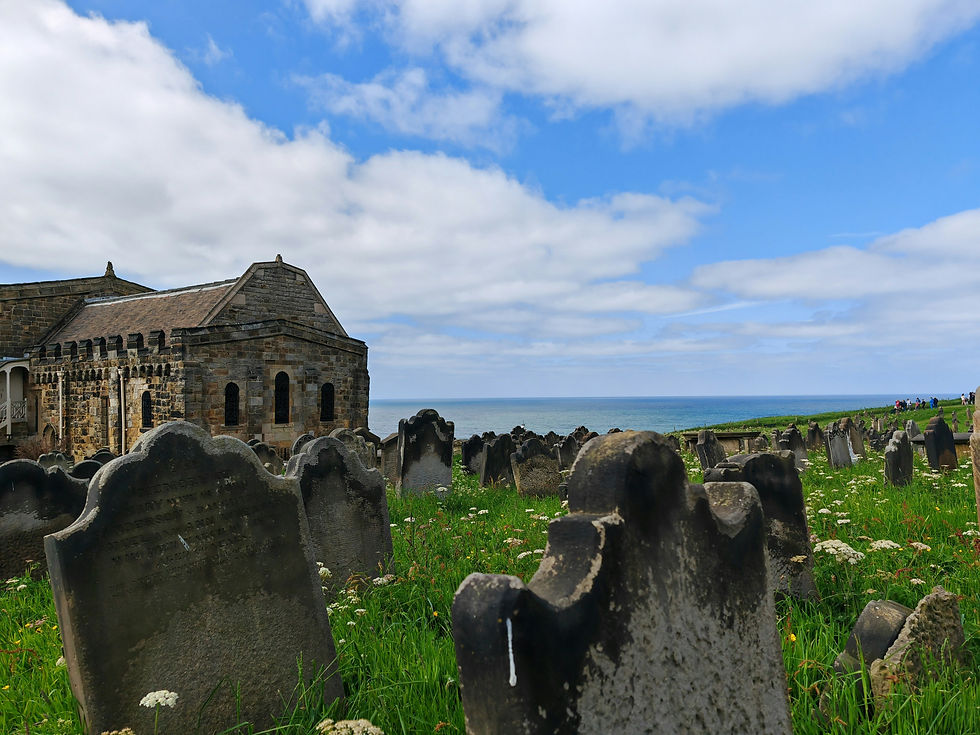Why Is Whitby Abbey So Crucial to the Easter Story?
- mariataylor37
- 13 minutes ago
- 3 min read

Whitby is a popular destination over the Easter Holidays. It is often regarded as the start of the season for our lovely coastal town however in recent years the season stretches over the whole year!
But we digress! In this Blog we are delving into the special link between Whitby and the Easter Celebration.
While many historical landmarks are linked to this event, Whitby Abbey stands out for its breathtaking views and ancient architecture. More importantly, it played a critical role in shaping the Easter calendar itself. This abbey, located on the North Yorkshire coast, was the site of a historic synod in 664 AD that determined the date of Easter, influencing how it is celebrated across various Christian traditions today. Join me as we explore the significance of Whitby Abbey, its historical context, and why it is so intertwined with the Easter story.
The Historical Significance of Whitby Abbey
Whitby Abbey was founded in the 7th century by Abbess Hilda, a prominent figure in early British Christianity. Far more than a place of worship, it became a cultural and educational center at a time of significant change within the Christian community.
When Roman missionaries arrived, they introduced different practices concerning crucial elements like the calculation of Easter. Celtic Christians, including those at Whitby, followed a separate method for determining this cherished holiday. A notable example of this discord was exhibited by monks from Lindisfarne, who adhered to the Celtic practice. This led to debates about which method to follow, prompting the need for a resolution.
The convening of the Whitby Synod aimed to unite these conflicting practices. It brought together key figures like the Venerable Bede, who strongly advocated for Roman practices, and Bishop Colman, who defended the Celtic customs. Ultimately, the synod decided to adopt the Roman method for calculating Easter. This not only solidified the church’s authority but also set a standard that would influence the observance of Easter in Britain and beyond for centuries.
The Whitby Synod and Its Impact
The Whitby Synod was a pivotal event in Christian history. Held in 664 AD, its purpose was to resolve the disagreements between the Celtic tradition and the Roman rite.
Bishop Colman defended the Celtic side, emphasizing the traditional methods of the early church. In contrast, King Oswiu championed the Roman approach, believing that it would bring greater consistency to the rapidly growing Christian community in England.
The outcome favored Oswiu. This decision not only determined how Easter would be calculated moving forward but also served as a crucial turning point for Christianity in Britain. The decision at Whitby had far-reaching implications. It set a precedent for future discussions about church practices, emphasizing the importance of dialogue and compromise. Key takeaways from this synod continue to shape Christian doctrine today, underscoring the lasting influence of this historic location.
Whitby Abbey’s Role in Modern Easter Celebrations
Today, Whitby Abbey stands as an iconic symbol of Easter and is a pilgrimage site for many. The imposing ruins overlook the coastline, providing a picturesque backdrop for reflection and prayer during the Easter season.
Every year, thousands visit the abbey to experience its historical significance and participate in Easter celebrations. These community gatherings not only honor the spirit of Easter but also foster a sense of unity and hope. Remarkably, over 70,000 visitors come to Whitby Abbey annually.
Exploring Whitby Abbey
For anyone wishing to deepen their understanding of the Easter story, a visit to Whitby Abbey is essential. The thrilling views from the abbey offer insight into how its location influenced early monastic life.

Exploring the ruins allows you to imagine the debates that occurred here centuries ago. This setting enables modern visitors to reflect on the necessity of unity within Christianity, amidst the historical challenges faced by early believers. The physical remains of the abbey serve as a reminder of the perseverance and commitment of those who stood firm in their faith.
Final Thoughts
Whitby Abbey is not just a scenic ruin; it is a crucial part of the Easter story. The decisions made during the Whitby Synod shaped the observance of Easter and highlighted the ongoing discussions within Christianity about tradition and evolution.
As Easter approaches, reflecting on the historical context of the holiday can deepen our appreciation for it. Whitby Abbey is a powerful reminder of faith's journey, the importance of understanding our history, and the shared experiences of believers over time.

Whether you're planning a visit or simply reflecting on the meaning of Easter, keep in mind the essential role of Whitby Abbey in this cherished holiday. May your Easter be filled with joy and renewal and we hope to welcome you to The Endeavour!
Commentaires